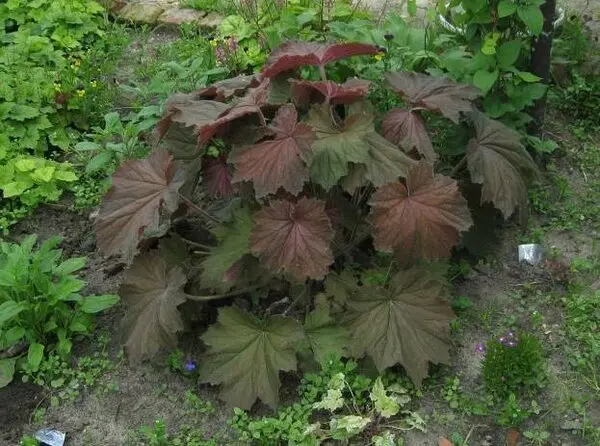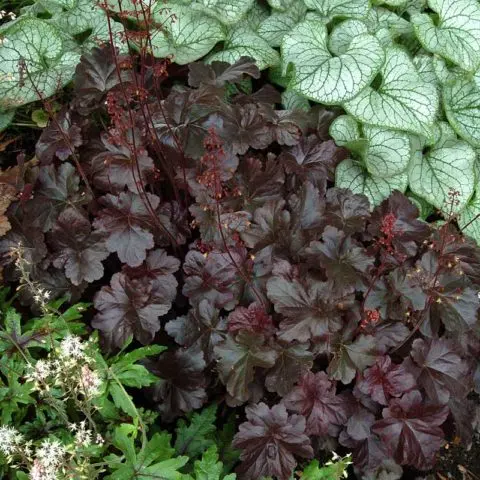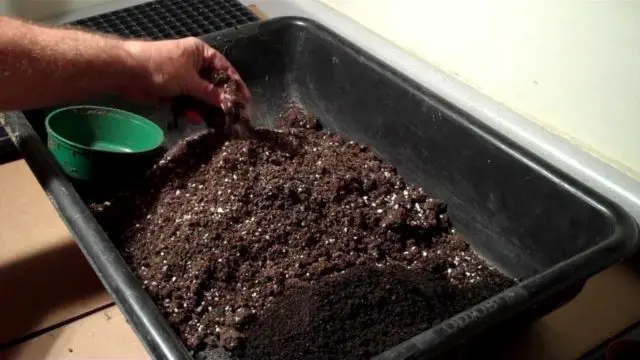Contents
- Is it possible to grow geyhera from seeds
- Features of propagation of geyhera seeds
- When to plant geykhera for seedlings
- How to plant geyhera seeds
- How many geyhera seeds germinate
- Why does geyhera not sprout from seeds
- How to grow geyhera from seeds
- Transplanting geyhera seedlings to a permanent place
- Tips for Growing Heuchera from Seeds
- Conclusion
- Reviews about growing geyhera from seeds
Geichera is a perennial plant with decorative leaves of the Saxifrage family. They grow it in the garden for decoration, because the foliage of the shrub changes color several times during the season. Seedlings are not cheap, so planting geyhera from seeds is fully justified. However, it is necessary to take into account all the features and subtleties of seed reproduction.
Is it possible to grow geyhera from seeds
Geichera is very easy to grow with seeds, however, it should be borne in mind that with this method, most of the varietal characteristics are lost. It is useless to collect seeds for further planting from your bushes. They do not retain the qualities of the mother plant. For planting, it is better to buy seeds in a flower shop.
Most often on sale there are seeds of hairy geyhera. The leaves of this variety are brightly colored. From a similar mixture, seedlings with purple, dark purple, black-brown and bronze color can be grown.

Heuchera seeds Emperor`s New Clothes are especially popular with gardeners. This is a mixture of varieties with wavy and corrugated leaves, which can be colored in dark cherry, emerald or light green.

Features of propagation of geyhera seeds
When buying seeds, pay special attention to their expiration date. The fact is that planting material retains its germination capacity for no more than six months. However, they can be stored in a vacuum foil bag for about 1,5 years.
Before planting, a change of geyher is prepared, but stratification can be dispensed with. They grow a herbaceous shrub in a seedling way, because it is very difficult to care for small seedlings in the garden. It is easier to get a container plant that is completely ready for transplanting. Although some gardeners practice sowing geyhera seeds in open ground before winter, somewhere in October or November.
Seedlings of geyhera take root well in a new place, as the seeds are collected from zoned varieties. They winter well and endure the vagaries of the weather.
When to plant geykhera for seedlings
Sowing geyhera for seedlings is best done from the end of March or at the very beginning of April. If the seeds are planted earlier, then the seedlings will have to be illuminated, because natural lighting in winter is not enough. With an early spring planting, you can do without it. Daylight is already increasing and the sprouts will have enough light.
How to plant geyhera seeds
Reproduction of geyhera by seeds is a fascinating activity, but it is worth remembering that young plants grow and develop very slowly. This should not be afraid and try in every possible way to accelerate their growth.
Preparation of planting containers and soil
To get friendly seedlings of geyhera seeds, a nutrient substrate is prepared. To do this, mix the following components:
- summit peat;
- washed river sand;
- garden land;
- wood ash.
For two parts of the earth, one part of all other components and 200 g of ash are taken. All components are thoroughly mixed and after that the finished substrate is sent to the oven to disinfect it. Shop soil for planting decorative leafy crops does not need to be cultivated.
As containers for growing seedlings, geyhers use ordinary plastic boxes. Initially, the seedlings are in a common container, after which they dive and grow in separate containers before transplanting. The boxes are pre-treated with an alcohol solution, potassium permanganate or special preparations to kill pathogens.
Seed preparation
Heuchera seeds are quite small and it is impossible to sow them evenly. Experienced gardeners recommend mixing planting material with sand. Before planting, the seeds are soaked for 20 minutes. in a solution of potassium permanganate, preparations “Kornevin” or “Zircon” to stimulate their growth. You can put the seeds for several days in the refrigerator, where the temperature is not higher than + 5 ° C. There they will swell and be ready for sowing.
How to plant a geyher for seedlings
In containers where perennials will be grown, drainage holes are made. A layer of expanded clay or other material is poured at the bottom and the containers are filled with nutrient soil.

To grow seedlings, geyhera seeds are not buried, but distributed on the surface of the soil. Landings are abundantly moistened with a spray bottle and covered with a film. The containers are exposed to the brightest place, but they are shaded from direct sunlight.
How many geyhera seeds germinate
After planting at home, geyher seeds are provided with a suitable microclimate so that shoots appear together. The air temperature is maintained at +20… +22°C.
The first sprouts in containers can be seen only after 2-4 weeks, in some cases even longer. But you don’t have to worry too much about this. Growing geyhera from seeds is a very slow process.
Why does geyhera not sprout from seeds
There are many reasons why seeds do not germinate after planting. And one of them is improper storage. Planting material must be stored in accordance with all requirements. It is best to keep the seed packets in a cold room or on the bottom shelf of the refrigerator. Since under normal conditions they quickly lose their germination.
In addition, the absence of seedlings for a long time indicates that the plantings were not properly cared for. Before the appearance of sprouts every day, the container must be opened for ventilation, otherwise the earth will be covered with mold due to high humidity. Spray the soil as needed. Containers are protected from drafts, especially at the time of ventilation.
How to grow geyhera from seeds
To grow a beautiful geyhera from seeds, as in various photos, you need to make a lot of effort.
Seedlings are very delicate and require special care. An inexperienced gardener can easily destroy tiny seedlings at the initial stage of cultivation.
Conditions for growing geyhera from seeds at home
When the first sprouts of geyhera appear after planting with seeds, they are provided with care. The film is not removed completely, but only lifted for a few minutes a day for airing. You can completely remove the shelter when a pair of true leaves appears on the seedlings. This is necessary to create the necessary climate, because tender seedlings require high humidity.
The air temperature in the room is slightly lowered so that the sprouts do not stretch. At night, +18°С is enough, but during the day it is maintained at +20°С, at all stages of cultivation.
In order for geyhera seedlings to develop well, they need at least 12 hours of light per day. Containers with plantings during cultivation are rotated so that the seedlings grow evenly. Lighting should be bright, but seedlings are protected from direct sunlight. On cloudy days they provide illumination.
Watering and feeding
Water the geyher seedlings very carefully, trying not to soak the soil. This can cause fungal diseases. Thin seedlings are very sensitive to soil moisture. In order to avoid mistakes in watering when growing, it is better to use a syringe or a small syringe for this purpose. You need to irrigate the seedlings every few days, after which it is necessary to ventilate the container.
Feed the geyher seedlings after two true leaves appear on them. Use complex mineral fertilizers, but dilute them in low concentration.
Picks
Heuchera seedlings grown from seeds are planted in separate containers when they are strong enough, and a third leaf appears on them. Can be planted in a common container, but leave a distance of 5 cm between plants.

For the first time after transplantation, the plants are covered with a film and removed to a shaded place so that they take root well. Further grown as usual.
Hardening
In May, seedlings begin to be taken out into the street so that they get used to the surrounding conditions. At first, the pots with plants are left for a few minutes, gradually the time is increased. Before transplanting, the seedlings are left outside all night. Containers with plants are left in the shade so that they do not suffer from the scorching sun. In the evening, be sure to check the soil moisture, if necessary, water the plantings.
Hardened seedlings will better tolerate transplantation, quickly adapt to new conditions and begin to grow. For hardening take 10-14 days.
Transplanting geyhera seedlings to a permanent place
In open ground, geyhera is transplanted in late May or early June, when night frosts pass and a stable temperature is established. Timings vary from region to region.
If geyhera seedlings were grown in a greenhouse, then transplanting to a permanent place can be postponed until autumn. However, it must be remembered that there should be enough time before the first frosts so that young plants have time to adapt and take root. For the winter, they must be covered with spruce branches.
Tips for Growing Heuchera from Seeds
In order for a shrub to fully reveal all its qualities, it needs to find a suitable place for growing. It is best to plant geyhera in partial shade, where the sun’s rays will fall on the leaves only in the morning. The soil for growing is preferably loose, nutritious and well-drained. Areas with wetlands or lowlands are not suitable for planting geyhera. The plant does not tolerate stagnant moisture at the roots.
Heuchera bushes do not grow quickly, so a distance of up to 20 cm is left between plants. The wells are prepared in advance and filled with humus. Seedlings are planted together with an earthen clod so as not to injure the root system.
Growing geyhera outdoors is easy. The shrub is unpretentious, it needs proper watering, weeding and timely top dressing. Water the geyhera 2 times a week, but during the drought period, you will have to moisten the soil every day. Moreover, water should be poured only into the root zone, but not on the leaves. In summer, the bush is watered in the evening and early in the morning. To maintain soil moisture, you can mulch the geyhera with humus.
A few hours after watering, the soil is loosened to provide oxygen to the roots, and weeds are removed. From time to time, the bushes spud, as young shoots appear around them.
Feed the geyhera in the open field 2 times per season. Use mineral fertilizers, but low concentration. In the second half of summer, all top dressing is stopped.
In the Southern regions, geyhera winters well in the open field without additional shelter. However, in the northern regions, where winters are harsh or snowless, in autumn the bushes are highly spudded, mulched with dry humus, covered with spruce branches or covering material.
If you follow all the recommendations for sowing seedlings and growing geyhera, then the shrub practically does not get sick and is not affected by pests. However, improper watering leads to such common diseases:
- powdery mildew;
- rust;
- root rot;
- leaf spot.
Affected bushes are treated with copper preparations, but they do not help with root rot. Sick plants will have to be uprooted. The landing site is disinfected so that the fungus does not spread to neighboring plants.
Of the pests, geyhere are most bothered by:
- slippery;
- snails;
- caterpillars;
- nematode;
- long-nosed.
They need to be controlled with insecticides. Processing is carried out several times per season. The first time geyhera is sprayed in early spring, when the leaves bloom. Then a few more times with an interval of 2-3 weeks.
If there are few pests, then you can try folk methods. From caterpillars, snails and slugs, dusting plants and row spacing with mustard powder, ground hot pepper or eggshell helps well. The delicate body of the insect does not tolerate such contact, so they leave. Some gardeners catch slugs by hand. To do this, a cardboard trap is set in a shady place in the garden. Every evening you need to remove all the snails and slugs that hid under it.
Conclusion
Planting geyhera from seeds is not much different from growing other plants. However, the shrub loses its decorative qualities, which may not be important for amateurs. Special care for geyhera is not required, simple manipulations are enough, and a plant with bright foliage will decorate the garden for many years.









